More doors from my (local) travels…
This is the main entrance to a bar in Boston. I guess it’s not considered a nightclub, or it would have to comply with the revised requirements for nightclubs in Massachusetts. The three locks are not code-compliant regardless, but I wonder how the codes define a nightclub. Anyone know?
This is a restaurant entrance pair and although they’re not necessarily a code problem, they’re hideous! If the plates are holding the doors together, it’s time for new doors!
An inexpensive hold-open:
I never would have thought that a lock with an indicator would require so much explanation:
Here’s another bathroom door…6 stalls, panic hardware, and a deadbolt. Why?
And finally, one of my favorite BBQ restaurants needs a longer panic device for its main entrance. The door is more than 3′ wide, and the device that’s installed is for a 3′ door. Since the codes require the actuating portion of the device to be at least half the width of the door, this one isn’t wide enough.
I see interesting doors every day, so stay tuned for more!
You need to login or register to bookmark/favorite this content.

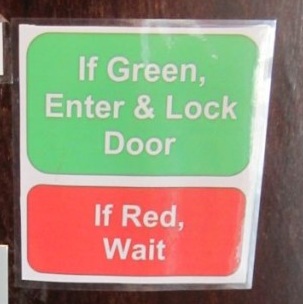
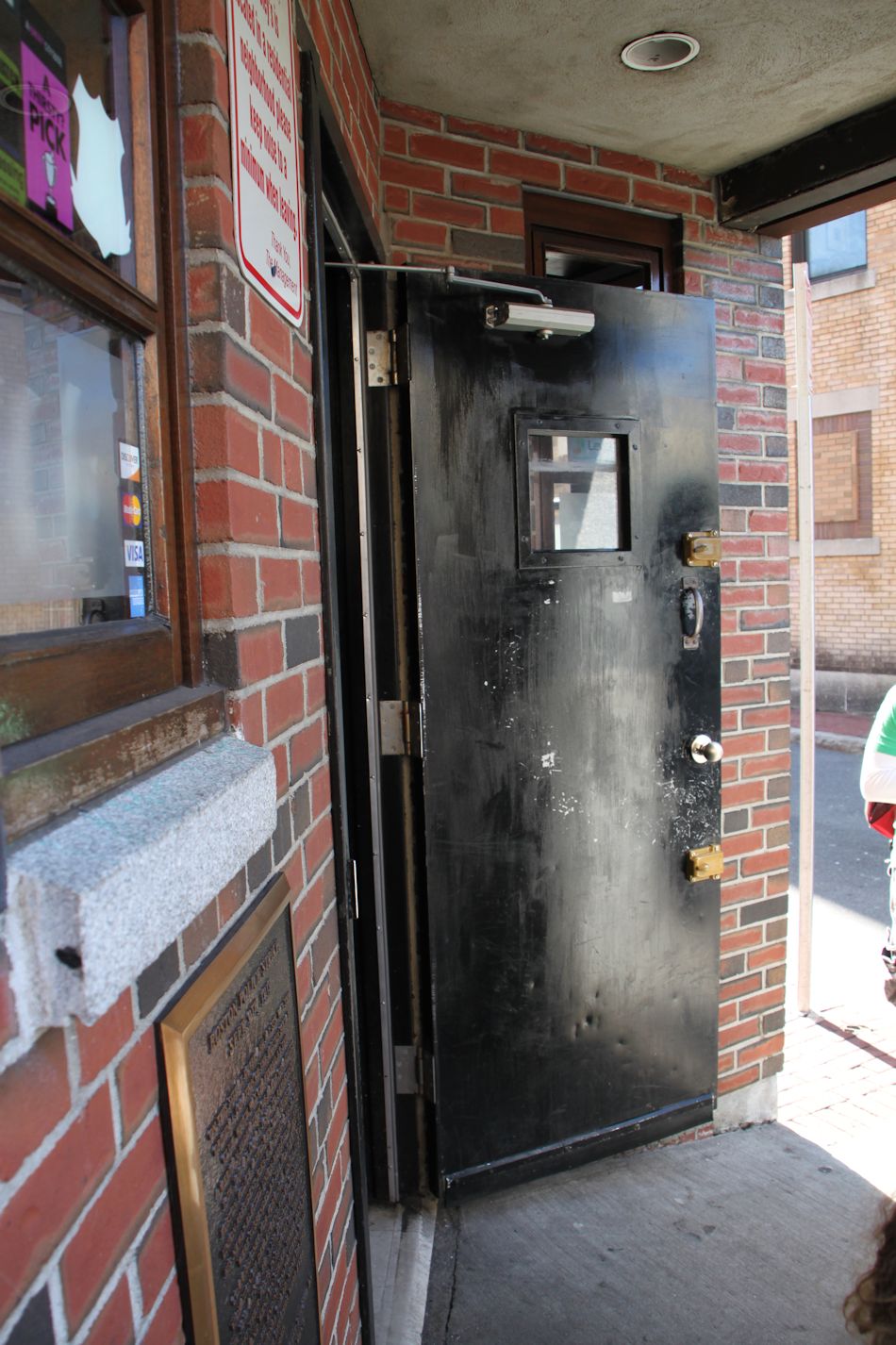
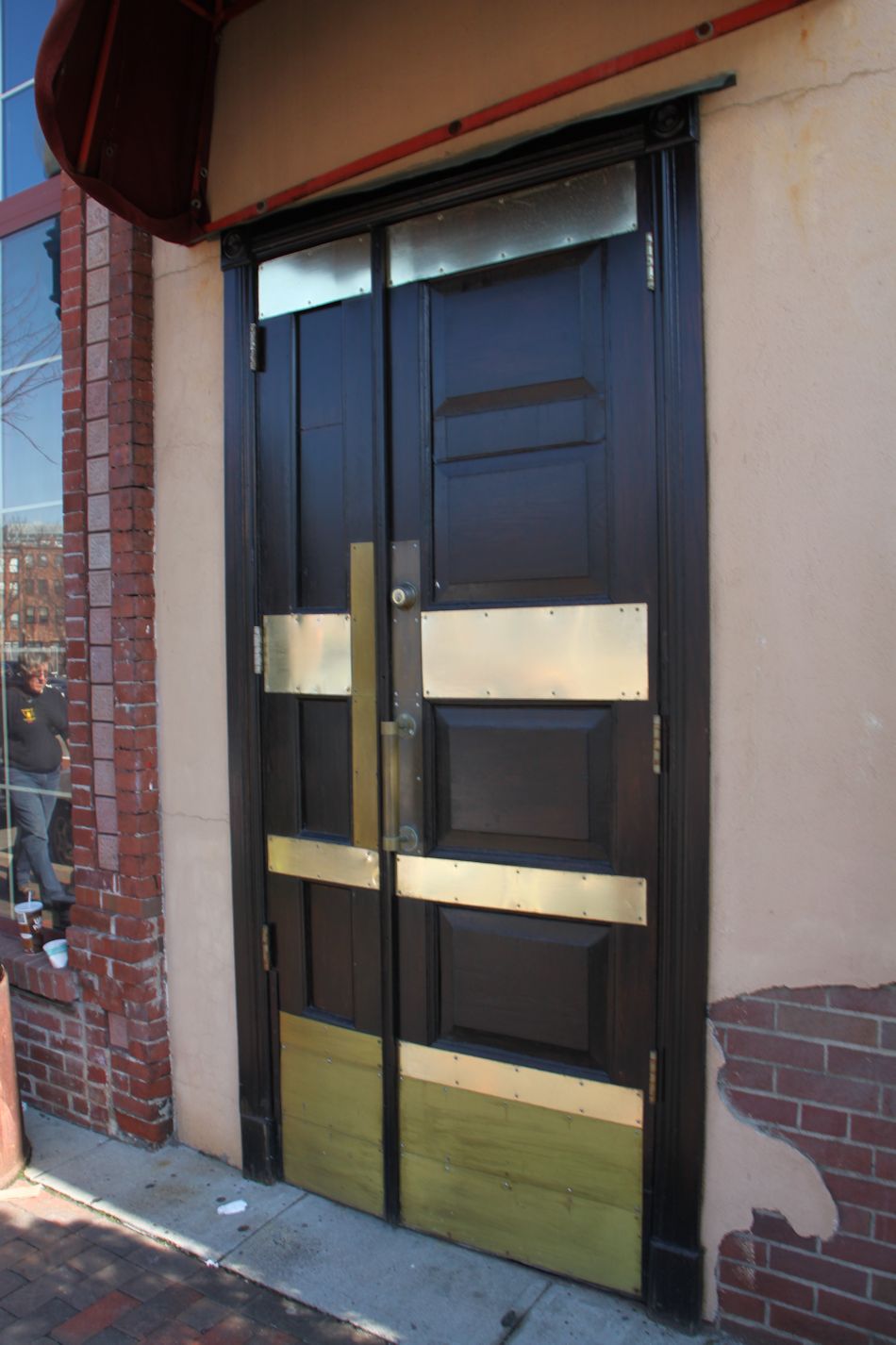
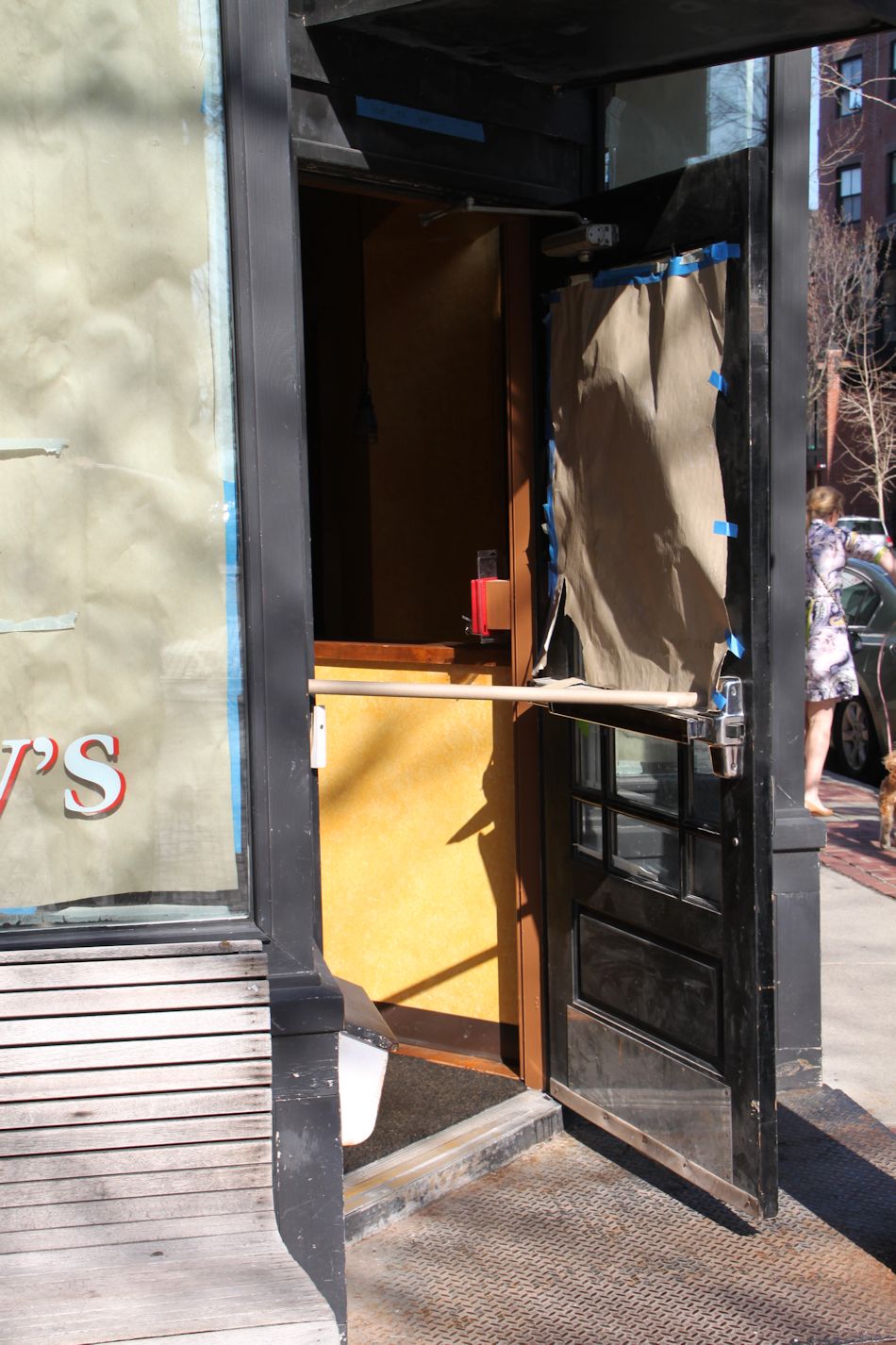
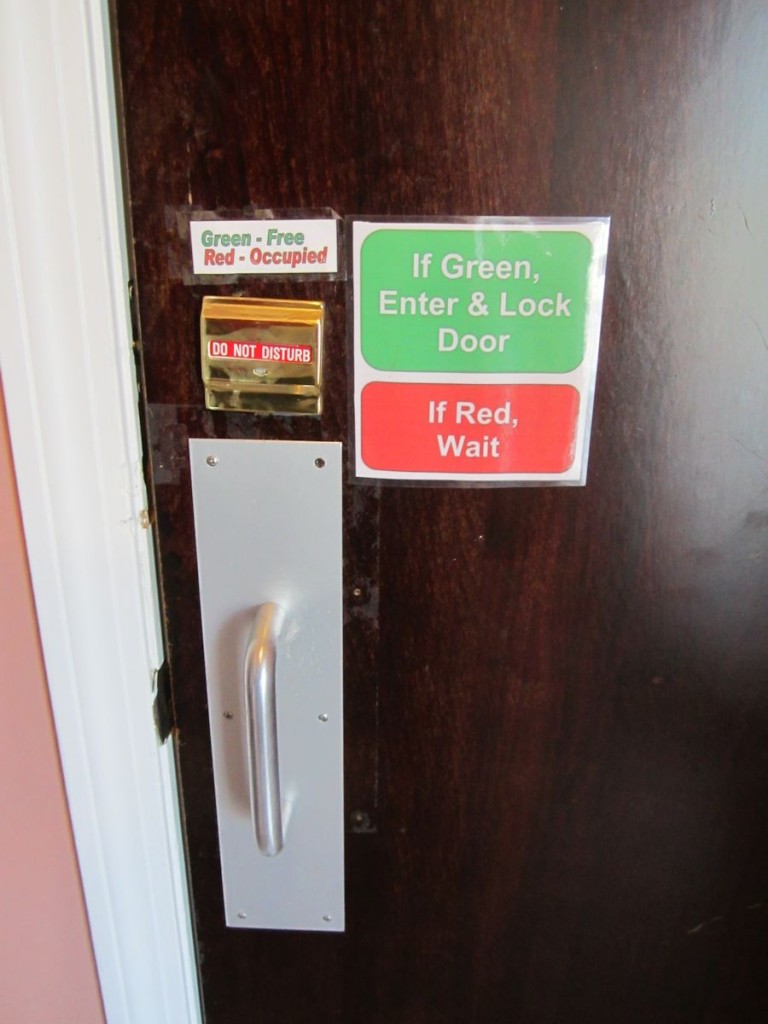
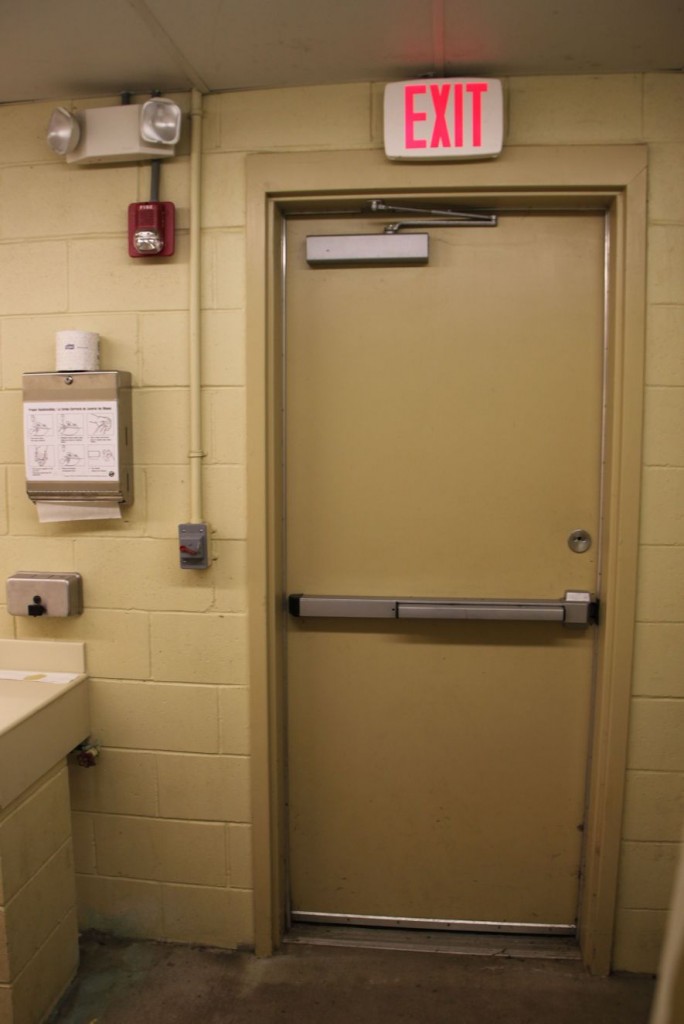





Base black and white ibc:::;
Code does not care either a-2 over 50 people or b under 50 people
SECTION 303 ASSEMBLY GROUP A
303.1 Assembly Group A. Assembly Group A occupancy includes, among others, the use of a building or structure, or a portion thereof, for the gathering of persons for purposes such as civic, social or religious functions; recreation, food or drink consumption or awaiting transportation.
Exceptions:
1. A building or tenant space used for assembly purposes with an occupant load of less than 50 persons shall be classified as a Group B occupancy.
2. A room or space used for assembly purposes with an occupant load of less than 50 persons and accessory to another occupancy shall be classified as a Group B occupancy or as part of that occupancy.
3. A room or space used for assembly purposes that is less than 750 square feet (70 m2) in area and accessory to another occupancy shall be classified as a Group B occupancy or as part of that occupancy.
4. Assembly areas that are accessory to Group E occupancies are not considered separate occupancies except when applying the assembly occupancy requirements of Chapter 11.
5. Accessory religious educational rooms and religious auditoriums with occupant loads of less than 100 are not considered separate occupancies.
Assembly occupancies shall include the following:
A-1 Assembly uses, usually with fixed seating, intended for the production and viewing of the performing arts or motion pictures including, but not limited to:
Motion picture theaters
Symphony and concert halls
Television and radio studios admitting an audience
Theaters
A-2 Assembly uses intended for food and/or drink consumption including, but not limited to:
Banquet halls
Night clubs
Restaurants
Taverns and bars
A-3 Assembly uses intended for worship, recreation or amusement and other assembly uses not classified elsewhere in Group A including, but not limited to:
Amusement arcades
Art galleries
Bowling alleys
Community halls
Courtrooms
Dance halls (not including food or drink consumption)
Exhibition halls
Funeral parlors
Gymnasiums (without spectator seating)
Indoor swimming pools (without spectator seating)
Indoor tennis courts (without spectator seating)
Lecture halls
Libraries
Museums
Places of religious worship
Pool and billiard parlors
Waiting areas in transportation terminals
Thanks Charles. I see the definition of an A-2 occupancy – an Assembly use intended for food or drink consumption. But the code language in the Mass State Building Code applies to nightclubs only – Use Group A-2nc. I have not been able to find a definition of A-2nc. What’s the difference between a nightclub and a tavern/bar?
“Here’s another bathroom door…6 stalls, panic hardware, and a deadbolt. Why?”
An exit device in the ladies room? Is the toilet room part of the exit corridor?
Regarding the deadlock… is that a thumbturn? Image isn’t real clear, almost looks like might be a blank plate.
Good eye Doorman! The deadbolt had a blank plate. I think the problem is that sometimes the people installing the deadbolts don’t know about classroom function deadbolts. They’re trying to avoid having an unauthorized person lock the door, so they install a double-cylinder deadbolt or one-sided deadbolt, not realizing they could accomplish this AND allow people to safely exit with a classroom function deadbolt. Either way it shouldn’t be in addition to a panic device.
The bathroom was a stand-alone building at a Girl Scout camp, where I spent two 30-degree nights recently (I’m collecting points toward my Mom-of-the-Year award). There was no reason that I can think of for a panic – definitely no code-related reason.
I did see a picture of a “dogged door “”
http://animal.kukuchew.com/wp-content/uploads/2009/05/vet_visit-dog-refuse-go-into-door.jpg
I found this article about a tavern turned nightclub, which didn’t meet the requirements for a nightclub: http://northamptonmedia.com/blog/01/10/2011/building-commissioner-denies-pct-nightclub-permit/
“On Friday and Saturday nights, the tavern brings in a DJ, clears the restaurant floor of tables and chairs, and allows dancing.”
Not sure if MA defined it
A-2nc Use Group – Nightclubs (defined same as Automatic Sprinkler Appeals Board memorandums)
A-2r Use Group – Assembly occupancy with food/beverage consumption (banquet halls, taverns, bars, restaurants)
Unless it is in the sprinkler appeal memo
Finally I think, from the current 8th edition of MA ibc
303.1.1 Add section:
303.1.1 Definitions.
NIGHT CLUB. An occupancy generally characterized by a combination of any of the following: no theatrical stage accessories other than raised platform; low lighting levels; entertainment by a live band or recorded music generating above-normal sound levels; later-than average operating hours; tables and seating arranged or positioned so as to create ill defined aisles; a specific area designated for dancing; service facilities for alcoholic beverages with limited food service; and high occupant load density.
The link
http://www.mass.gov/eopss/docs/dps/8th-edition/3-use-and-occupancy-classification.pdf
Regarding the use of Deadbolts – we use the classroom function (thumbturn only unlocks, key required to lock) on gang toilets so that the room can be locked if vandalization makes the room unusable (sorry – I’m talking K-12 schools).
Lori – congrats on the 30 degree nights. I assume you are talking F not C. In the Boy Scouts we awarded a plastic “ice cube” to scouts if a cup of water froze over when left on the table. And they had to be in tents. The trick is to stay dry and insulated from the ground.
That’s exactly what I use on multi-stall toilets too.
Yes, I am talking F. It was FREEZING and we were in tents, but luckily my flask didn’t freeze over. 🙂
Lori:
It appears that the Massachusetts building code has a separate Assembly sub-occupancy type for nightclub, A-2nc, which should be defined in its code, but universally a nightclub is Assembly Group A-2 (IBC 303.3) subject to exceptions for <50 persons occupant load (Group B, 303.1.1, and 303.1.2 1. or part of dominant occupancy), and <750 square feet (Group B, 303.1.2 2.); nightclubs are not addressed as an occupancy sub-type under LSC 3.3.188.2 and 6.1.2.1 Assembly Occupancy and its Annex, except for uses (9) dance hall and (10) drinking establishment and the eating, drinking, amusement, or entertainment for gathering of ≥50 persons, otherwise it would be a mercantile occupancy if <50 persons (A.3.3.188.2 and A.6.1.2.1).
Jimmy Parker, Architect